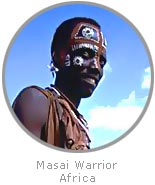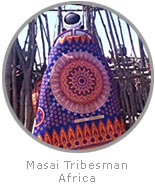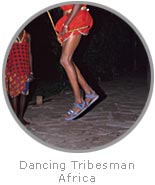|
In the heart of Africa there lived a precious little girl named Ianu. Ianu loved life and life appeared to love her as well. She displayed the countenance of one who wonders, but is not skeptical; dreams but does not fabricate; and laughs but never sneers.
 On this new day Ianu watched her father as he hunted for their dinner. She noticed his stealth and grace as he approached a herd of antelope. Having speared his prey, her father knelt and prayed for its spirit before skinning it. He told Ianu, “God provides the antelope for our dinner, and tonight the antelope will dine with God.” On this new day Ianu watched her father as he hunted for their dinner. She noticed his stealth and grace as he approached a herd of antelope. Having speared his prey, her father knelt and prayed for its spirit before skinning it. He told Ianu, “God provides the antelope for our dinner, and tonight the antelope will dine with God.”
Back at home she helped her mother who was making a basket. Carefully she wove each reed so that the basket was not just a container, but also a seamless circle of recurring patterns which told a story. Her mother explained, “Weaving a basket is hard work, but the story gives the basket life, and makes it more than just a container. So, the work does not seem burdensome.”
 Later that day Ianu visited the village high priest who was grinding berries in a small bowl. “Are you preparing dinner?” questioned the naive child. “No, I am grinding these dried berries to mix with roots and water in order to have paint to color our faces for a ceremony we will be having soon. Berries, like many other gifts from nature, serve us in several ways.” Later that day Ianu visited the village high priest who was grinding berries in a small bowl. “Are you preparing dinner?” questioned the naive child. “No, I am grinding these dried berries to mix with roots and water in order to have paint to color our faces for a ceremony we will be having soon. Berries, like many other gifts from nature, serve us in several ways.”
That night, as the village settled in for gentle conversation around a communal fire, the elders heard a strange noise. They followed the sound through the thicket to the edge of a clearing. Uncertain of the source of the strange sound, they approached the clearing in silence.
What they beheld made them stop in awe.
 Close to a small fire, Ianu was dancing around the skull of the antelope. The skull lay in one of her mother’s baskets and the pattern of the basket was replicated on Ianu’s legs and arms and face and also on the head of the animal. After watching the small child dance for a while, the chief of the tribe asked, “Who taught this child to dance?” At first no one responded. Then her father said, “I taught her about the spirit of the antelope.” And her mother said, “It was I who spoke to her of the story baskets.” And lastly, the high priest acknowledged his instruction about the berries. “But,” the father asserted, “we still have not found the person who taught my daughter to dance.” Close to a small fire, Ianu was dancing around the skull of the antelope. The skull lay in one of her mother’s baskets and the pattern of the basket was replicated on Ianu’s legs and arms and face and also on the head of the animal. After watching the small child dance for a while, the chief of the tribe asked, “Who taught this child to dance?” At first no one responded. Then her father said, “I taught her about the spirit of the antelope.” And her mother said, “It was I who spoke to her of the story baskets.” And lastly, the high priest acknowledged his instruction about the berries. “But,” the father asserted, “we still have not found the person who taught my daughter to dance.”
 The wise chief smiled before congratulating his people. The wise chief smiled before congratulating his people.
“As legend foretold, it has taken our whole village to educate this child. Each of you has been a muse, teaching her an important lesson about life. One of you taught her to respect all beings; another to find meaning in work; and yet another to seek and celebrate hidden beauty. To these teachings the child has brought the inner rhythms of her own soul and she has found that dancing will always be her way of exalting the gift of life.”
It Follows:
Now and then, it takes a child to teach a whole village.
Ianu's Dance was written and narrated by Julie Reder Fairley. Character voices were provided by Matthew Linden, Anthony Reece and Evelyn O'Dwyer. This parable is dedicated to Janice Brinson.
|